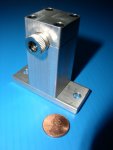Generally you must keep the maximum die temperature substantially under 150C. I seem to recall that the theta-JC (thermal resistance Junction to Case) is around 60 to 80 K/W for the 5.6mm packages, and given a diode operating point of say, 130ma with a forward drop drop around 4.8V for a bluray, this is 0.624w dissipated in the die / package. This will cause the die temp to rise by 0.624W X 70K/W = 44C rise above case temp. if you want your die temp to rise no higher than say, 125C, the case temp cannot be allowed to rise above 125-44C = 81C. If max design ambient = 50C, then you need to heat sink rated for at least (81-50)/.624 = 33C/W. If you drive the device harder, you will need correspondingly more heat sink.
Another design consideration is the fact that operating life will be decreased by a factor of two for every 10C that the die temp / case temp rises. This degradation is driven by chemical diffusion which, above an activation energy, increases exponentially with temp. Basically, bigger heatsink = less temp rise above ambient = longer life. (google on arrhenius equation) In the example above, going from a 33 C/W heat sink to a 18 C/W heat sink will decrease die temp by 10C and double your laser diode operating life in a 50C ambient.
An added benefit of heat sinking is that you will also get better power stability. With increasing die temperature, the lasing threshold current increases and the slope of the output curve decreases. This is why LD's get dimmer as they warm up . If you can hold the case temp closer to ambient with a larger heat sink, you will achieve better power stability with time because the die will not heat up as much.
Finally, laser diodes have another failure mechanism, namely catastrophic optical damage. If you increase the drive current too high, the optical energy density within the resonator exceeds the damage threshold of the materials. When this happens, the die melts or cracks. The point at which catastrophic optical damage occurs can vary from device to device, depending on any imperfections, manufacturing variability from part to part, lasing threshold and slope, die temperature, etc. This is why one diode may operate for a long time at 180ma, while another diode will fail immediately at 100mA current. Reflecting laser light back into the resonator from poorly designed optics can also increase the optical flux within the laser cavity, causing the damage to occur at a lower drive level. Catastrophic optical damage will happen in a matter of microseconds due to electrical transients or optical overstress. Interestingly, cooling some laser diodes too much without decreasing drive current can trigger the catastrophic failure mechanism due to shift in threshold current and slope causing higher emission at low temp.




